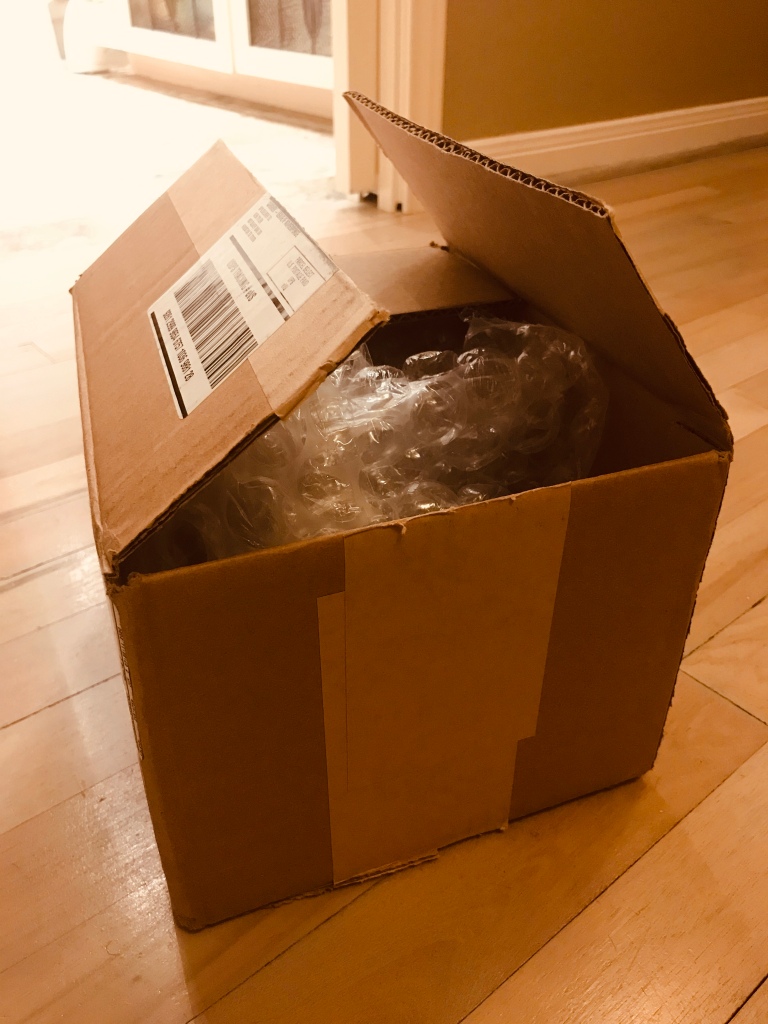E-commerce has boomed as a result of the coronavirus pandemic. Less widely noted, residential trash generation rates have spiked. One link between these trends is the additional shipping material showing up on doorsteps around the country and then making its way into residential trash and recycling bins. For most people, having to manage additional and to some degree unavoidable household waste falls somewhere between tedious and depressing and those more negatively impacted are often individuals who try very hard to reduce their individual environmental footprint. Seeing an increase in the volume of stuff destined straight for near-term disposal can feel like a defeat if one is working diligently to minimize this very thing.

All changes have upsides and downsides. This change has broadly visible downside manifesting where people live while the upsides are far less obvious. A balanced response requires seeing both the good and the bad. One key to appreciating the upside of this particular change is to learn to see your e-commerce packages as both the stuff you order and as little bundles of personal supply chain influence. Developing confidence that your little bundles of supply chain influence did their best to minimize their environmental impact regardless of whether they arrived in a too-large box filled with unnecessary air pillows is one way to mitigate frustration with excessive online purchase packaging. We’ll explain.
A bit of terminology clarification is needed. People who work in packaging classify packaging material into categories of primary, secondary, tertiary and so on. Primary packaging holds a product together; think of a potato chip bag holding a bunch of potato chips as primary packaging. Secondary packaging is packaging for packaging and is not in direct contact with a product; think of a grocery bag holding multiple bags of potato chips. A delivered online order is a combination of services, a product or products plus a delivery. Unlike when you lift a product off a store shelf and put it in your cart, and act which generally involves primary packaging only, a package delivered to your home usually includes both primary and secondary packaging where the box/bubble wrap/padded mailer etc. is the secondary packaging. Keeping this distinction in mind is important because primary and secondary packages serve different purposes.
The original title of this post was “Making Peace with Online Order Packaging in Three Easy Steps” and it was changed because there are already those who are at peace with online order packaging. For those that aren’t, the three steps are presented below.
Step #1: Define “over-packaged” according to packaging purpose.
The ideal amount of packaging needed from an environmental perspective is the minimum needed to do the job. For a product sold online, primary packaging needs to contain the product and meet minimum labeling requirements. When that same product is sold from a store shelf, the primary packaging also needs to attract interest from potential buyers but this function is less relevant for online sales. The main purpose of secondary packaging for online orders is to prevent returns due to damage. Returns are both an economic and environmental loss and so a little more mass per package to deliver a lower rate of product returns could make good environmental sense.
Treat excessive primary packaging and excessive secondary packaging as separate issues. It’s more accurate to consider secondary packaging as a way of seeing a little more deeply into the supply chain. Keep in mind that items on a store shelf arrived at the store in at minimum some secondary packaging and probably some tertiary packaging, all of which was managed outside the customer’s view. As online order volumes increase, consumers get more of a glimpse of what happens behind the scenes and many are really unhappy with what they see. Since unhappy customers drive change, we believe that ecommerce packaging is an area about to experience very rapid innovation.
And guess what other trend is being driven by the coronavirus pandemic? Commercial trash generation rates are down.
Step #2: Apply the right “R” at the right time.
Primary packaging and secondary packaging are at two different stages in the product lifecycle. This is important because the most environmentally effective question that can be asked about how to manage stuff depends on product lifecycle stage. With respect to an online order just delivered, the product, including the primary packaging, has just exited the “delivery” stage and is at the very beginning of the “use” phase. The secondary packaging has just exited the “use” phase and is just entering the “end of life” phase. Given the well-known hierarchy of “refuse, reduce, reuse, recycle”, keeping a product’s lifecycle stage in mind helps one apply the most appropriate “R” to understand probable options available for that product going forward.
The most environmentally effective question that can be asked about a product just entering the “use” phase of the product lifecycle, like an online order just received, is “Reduce”. “Refuse” is generally off the table at this point. “How can I extend the useful life of this?” or “Can this be used in a lower-impact way?” are the type of questions likely to yield greatest environmental impact for a product about to be used.

The most environmentally effective question that can be asked about a product just entering the “end of life” phase is “Reuse”. “Recycle” is the one to consider only if “Reuse” doesn’t work out. Secondary packaging for an online order received is at the “end of life” product lifecycle stage and the open question with the greatest potential environmental impact is whether there are viable reuse options worth pursuit. Given more than one reuse option, a hierarchy of environmental preferability applies. It’s preferable to reuse the secondary packaging its original form. It’s preferable if the secondary packaging doesn’t need to travel far in order to be reused. Even modified reuse, such as substituting used bubble mailers for bubble wrap, or partial reuse is generally preferable to recycling or discarding. The upside associated with secondary packaging is that it is much less likely to be customized to a specific product and therefore much easier to re-purpose than primary packaging. Time spent thinking through options for secondary packaging reuse is likely well spent in terms of environmental impact. Once a reuse solution for secondary packaging is found, it is likely, ahem, reusable.
Step #3: Prioritize cushioning the highest-impact stage in a product’s lifecycle.
An online consumer has the greatest ability to influence the total environmental impact of their purchases at the point of deciding to buy or not buy. Though there are exceptions to every rule, thoughtful procurement or non-procurement is the highest-impact lever a sustainability-minded consumer can pull. “Refuse”, the most powerful and least understood “R”, pulls up a chair and has a seat at the table when a buy-or-pass decision is being made, whether his presence is acknowledged or not. “What is it that I want to refuse and how much refusing can I do given other considerations?” is the often overlooked and often consequential question.
If the intent is to refuse as much environmental impact as possible (and all online purchases have some environmental impact), then the goal must be to refuse the greatest amount of environmental impact for the least cost while honoring other purchasing decision constraints. A product’s total environmental footprint is the sum of the impact of all stages in the product lifecycle. Logically, the most effective way to mitigate environmental impact through product selection is to select for superior environmental performance specifically during the highest-impact product lifecycle stage. To do this effectively, one needs to know in advance which product lifecycle stage likely has the greatest environmental impact for any product. Luckily, this can be much simpler than it sounds.
In general, for consumables (stuff intending to be used up and then replaced), the majority of the product’s environmental impact is associated with making the product in the first place. As an example, this study of the environmental impact of paper towels found that manufacturing paper towels has about an order of magnitude more impact than shipping, using and disposing of paper towels. Therefore, if paper towels are needed, buy them from a source working to reduce paper towel manufacturing footprint and, for now, don’t worry too much about the packaging and shipping impact. Packaging and shipping is relevant but in this case not the biggest lever that can be pulled. In contrast, for durable goods, like a hot water heater or a washing machine or an air conditioner, the result flips. Generally, the majority of the environmental impact from durable goods is incurred during the “use” phase. Therefore, to prioritize reducing the environmental impact of products like these, prioritize operational efficiency to the degree possible. Consumable / durable is a spectrum and many products fall somewhere between these two end members. For example, this summary of a Levi’s jeans study, jeans being a product somewhere in between clearly consumable and clearly durable, reported that most of the environmental impact of a pair of jeans was incurred during washing (use phase) … but only by a little bit. A change in the study’s jeans washing frequency assumption changed the study’s result, which indicates that the environmental impact of the manufacturing and the use of jeans is probably comparable. Toys, clothes, sports equipment and similar all fall into this gray area. When in doubt, assume consumable and for these less clear-cut cases that we’ll refer to as semi-consumable, there’s often the option of buying used. For products like jeans, trying to target the highest-impact phase of the product lifecycle may be, well, kind of a wash but buying used drops the effective environmental footprint of product’s manufacturing phase to zero and that alone tips the scales.
This post was inspired by a white paper that reported that 77% of consumers judge the environmental credentials of a company by their packaging. We’re proud of our company’s environmental credentials and given that we are an early-stage company still developing our products, packaging optimization is something we intended to address later. However, if 77% of all potential customers are going to judge us by our packaging then this needs to be addressed sooner. So, we have now adopted a goal of slowly increasing the fraction of packages that we ship in reused secondary packaging. We’re starting by making the mailers for our smallest single-item orders out of used paper grocery bags. And we’ve published an online guide to making these mailers at home.

Making mailers from paper grocery bags isn’t where we expect to end up long term. Nobody really has sustainable packaging figured out. Some of the most environmentally progressive companies out there have figured out how to use upcycled waste as primary packaging or have developed trackable, reusable secondary packaging or have designed packaging that serves as both primary and secondary packaging but no one has come up with a true zero-waste solution assuming a holistic zero-waste definition is applied. The upside of general dissatisfaction with current online order packaging norms is that this dissatisfaction should drive significant improvement the near-term. And until such improvement manifests, we hope that our three-step approach to seeing and leveraging the upsides of online order packaging is helpful for both managing the status quo and making your future bundles of supply chain influence a bit more influential. Please use your power wisely.
We can always be reached through our contact page.
Thanks for your interest and support.

Amazing Sara! You are my kind of lady! I have only tossed away a couple bags of garbage in the past couple years, always looking for ways to repurpose and reuse!
LikeLike